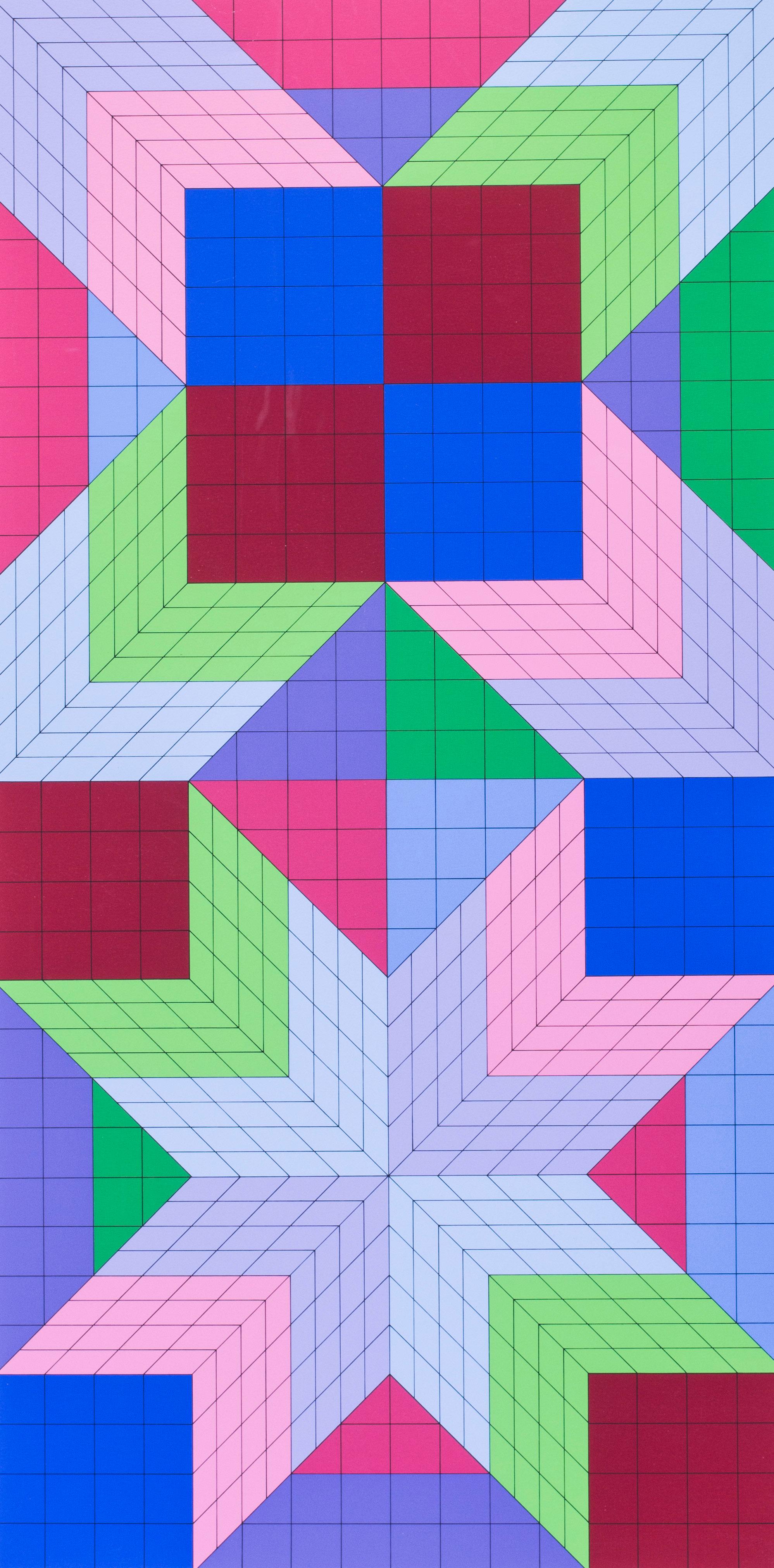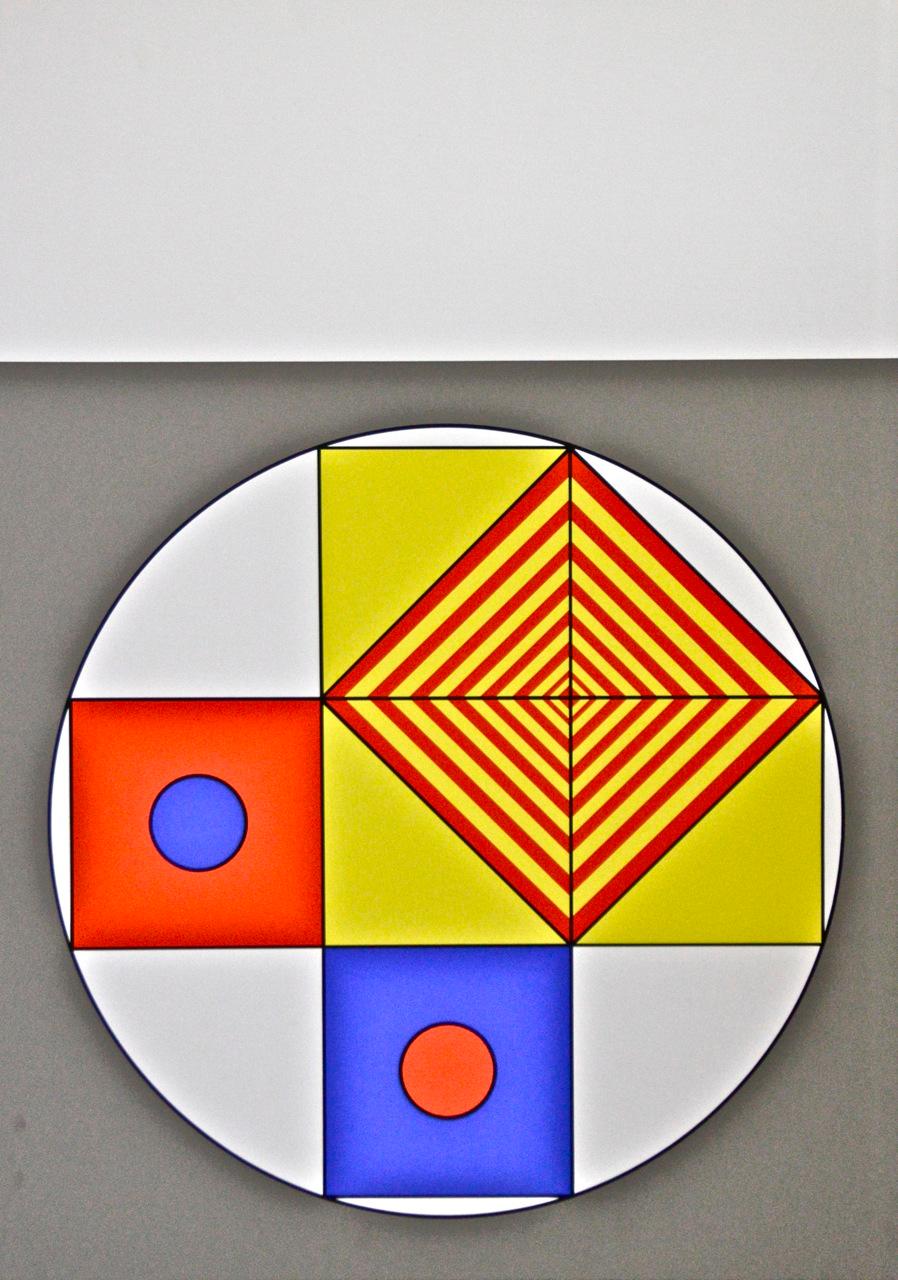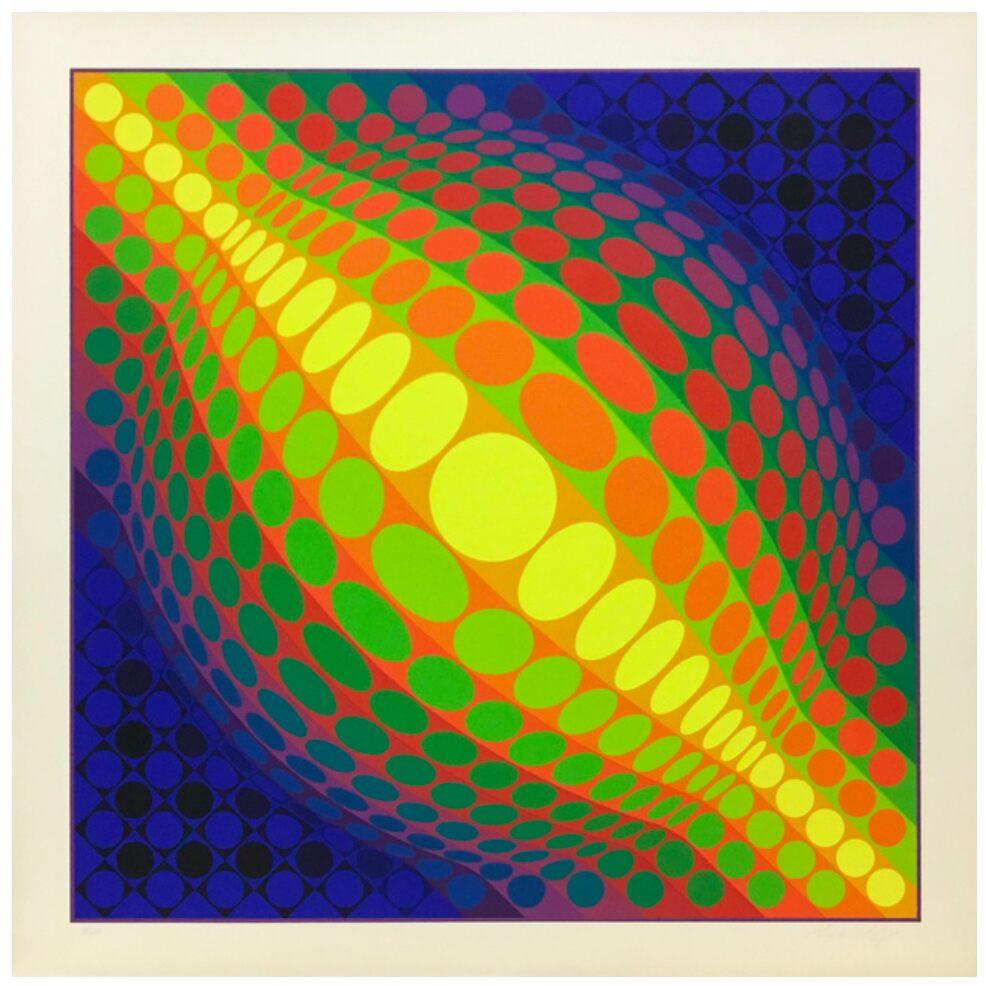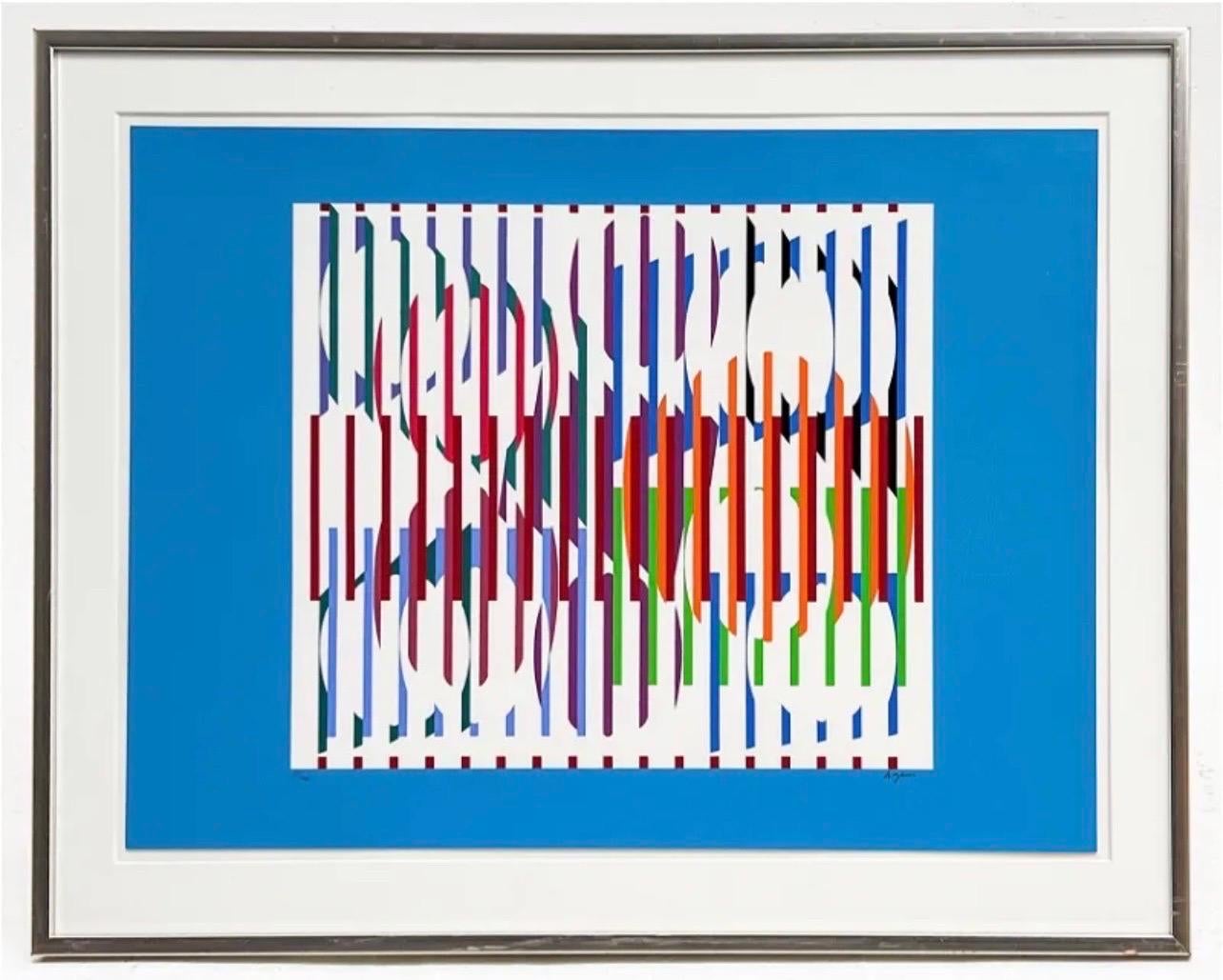Items Similar to 1970's Op Art Cintique Geometric Abstract Color Gradations Silkscreen Domberger
Want more images or videos?
Request additional images or videos from the seller
Luitpold Domberger1970's Op Art Cintique Geometric Abstract Color Gradations Silkscreen Domberger1970
1970
About the Item
Silkscreen serigraph Op art print.
Luitpold Domberger (1912-2005 ) was a pioneer of artistic screen printing in Germany.
Luitpold (Poldi) Domberger studied from 1928 at the art and trade school in Pforzheim, where he then worked as a freelance commercial artist before moving to Stuttgart in the mid-1930s. At the end of the 1940s he came into contact with the new medium of screen printing through a visit to an exhibition in the Amerikahaus in Stuttgart. He set up his first screen printing workshop in 1949 at Gänsheidestrasse 26 in Stuttgart. His neighbor there was the artist Willi Baumeister. The screen printer and the artist worked together, which resulted in almost 60 serigraphs being produced between 1950 and Baumeister's death in 1955. Inspired by the first exhibitions of the Baumeister screen prints, other artists soon also had Domberger print. In the years that followed, Domberger had a decisive influence on the newly emerging profession of the screen printer; Young printers like Hans-Peter Haas emerged from his workshop. At the end of the 1960s, Edition Domberger was founded at the new printing site in Plattenhardt near Stuttgart, and it still exists today under the management of his son, the screen printer Michael Domberger.
From the 1950s onwards Domberger created serigraphs for many internationally known artists, including Max Ackermann , Josef Albers , Keith haring, Cy Twombly, Max Bill , Richard Estes , Adolf Fleischmann , Otto Herbert Hajek , Richard Hamilton , Robert Indiana , Nicholas Krushenick , Roy Lichtenstein , Georg Karl Pfahler , Victor Vasarely and Ben Willikens. From Pop art and Op art to Minimalism, Photorealism and Conceptual art. They have a long history of working with women artists, among them German conceptualist Hanne Darboven and Anni Albers. They also had an instinct for cool Op artists, and, in particular, the hard-edge color-field painters of the 1960s. Prints from Domberger can now be found all over the world at trade fairs, in the art trade and in many graphics auctions and collections.
- Creator:Luitpold Domberger (1912 - 2005)
- Creation Year:1970
- Dimensions:Height: 28 in (71.12 cm)Width: 27.5 in (69.85 cm)
- Medium:
- Movement & Style:
- Period:
- Condition:it is attached to the mat and has some waviness to the piece. size includes mat.
- Gallery Location:Surfside, FL
- Reference Number:1stDibs: LU3827504012
About the Seller
4.9
Platinum Seller
These expertly vetted sellers are 1stDibs' most experienced sellers and are rated highest by our customers.
Established in 1995
1stDibs seller since 2014
1,553 sales on 1stDibs
Typical response time: 1 hour
- ShippingRetrieving quote...Ships From: Surfside, FL
- Return PolicyA return for this item may be initiated within 3 days of delivery.
More From This SellerView All
- Agam Silkscreen Mod Judaica Lithograph Hand Signed Israeli Kinetic Op Art PrintBy Yaacov AgamLocated in Surfside, FLYaacov Agam Israeli (b. 1928) Hommage aux Prix Nobel (1974) Serigraph signed lower right, numbered 85/100 sheet: 22 x 29 3/4 inches frame dimensions: 28 x 35 1/2 x 1 inches, wood fra...Category
1990s Op Art Abstract Prints
MaterialsLithograph, Screen
- Banya, 1964 Vintage Abstract Op Art Screen Print SerigraphBy Victor VasarelyLocated in Surfside, FLScreen print square, inscribed 'Vasarely' at bottom, hung diagonally, sides of the square 23 1/2 x 23 1/2 (59.5 x 59.5); as hung, 33 x 33 (84 x 84). VICTOR VASARELY (1908-1997) In...Category
20th Century Op Art Abstract Prints
MaterialsScreen
- Op Art, Kinetic 1970s Original Vintage Silkscreen Lithograph PrintBy David RothLocated in Surfside, FLHand signed and numbered limited edition print. David Roth studied at the Illinois Institute of Technology's Institute of Design and was twice the recipient of the Moholy-Nagy Scholarship in visual design. It was Roth's initial work as a designer at fine art for commercial use that brought him interesting positions as art director for Lanvin, Charles at the Ritz, and Germain Monteil. . The strings are tied in bunches and closely hung tram a wooden bar. The size and shape of the string is similar to that at a canvas painting. Each bundle is represented by a vertical row at squares on the graph and the groupings at string are lined up along the wall according to the horizontal rows at the program. The six primary and secondary colors are used in their full intensity along with black, grey, and white. As a painter Roth works to formulate with color. Some painters regard color as a concomitant of form, hence a subordinate, but Roth's color is the chief medium of his pictorial language. A programmed juxtaposition at primary color allows Roth and the viewer to play upon various combinations. The graphs Roth executes are proportioned according to a strict mathematical formula - the pictures are Composed according to horizontal and vertical divisions on the graph paper. The optical quality of color, deliberately sought, has its roots in the Bauhaus investigations of illusion, and thus has a direct relationship to the Op art produced in postwar Europe. Roth has arranged his hues so as to persuade the planes to separate from the ground on which they are planted, and float free in space. It is almost as if Roth is giving us a "readout" on his creative process. Although the graphs appear to vary in their use of color the same colors are used throughout, also the same amount of color. Roth's work illustrates the sophistication of the human eye-brain relationship that has developed and invites the viewer to participate in the evolution at visionary ideas. One Man Shows 1966 The Gallery Upstairs, Buffalo, New York 1967 The Gallery Upstairs, Buffalo, New York 1969 The House of Graphics, New York 1969 Illinois Institute of Technology, Chicago, Illinois 1972 Robert Elkon Gallery, New York 1973 Robert Elkon Gallery, New York 1974 Robert Elkon Gallery, New York 1975 Michael Wyman Gallery, Chicago 1975 Robert Elkon Gallery, New York 1976 G.W. Einstein, New York 1976 Robert Elkon Gallery, New York 1977 Robert Elkon Gallery, New York 1977 G.W. Einstein, New York 1978 Sunne Savage Gallery, Boston, Massachusetts 1978 Robert Elkon Gallery, New York 1979 Nancy Roth Gallery, Katonah, New York Group Exhibitions 1967 State University of New York, Buffalo 1970 Ronald Feldman Gallery 1970 The Everyman Gallery 1971 Robert Elkon Gallery, New York 1972 The Brooklyn Museum, New York 1972 The Newark Museum, New Jersey 1972 Art...Category
1970s Op Art Abstract Prints
MaterialsScreen
- Agam Silkscreen Jerusalem Lithograph Hand Signed Israeli Kinetic Op Art PrintBy Yaacov AgamLocated in Surfside, FLYaacov Agam, Israeli (b. 1928) Hand signed, not individually numbered but from edition of 180. I can include a copy of the title sheet with the edition size and his signature if you ...Category
1980s Op Art Abstract Prints
MaterialsLithograph, Screen
- Agam Silkscreen Mod Judaica Lithograph Hand Signed Israeli Kinetic Op Art PrintBy Yaacov AgamLocated in Surfside, FLYaacov Agam Israeli (b. 1928) Hand signed, not individually numbered but from edition of 180. I can include a copy of the title sheet with the edition size and his signature if you r...Category
1980s Op Art Abstract Prints
MaterialsLithograph, Screen
- Agam Silkscreen Mod Judaica Lithograph Hand Signed Israeli Kinetic Op Art PrintBy Yaacov AgamLocated in Surfside, FLYaacov Agam Israeli (b. 1928) Hand signed, not individually numbered but from edition of 180. I can include a copy of the title sheet with the edition size and his signature if you request. sheet: 13.5 X 13.5 inches Some of these works have beautiful Hebrew calligraphy and mod imagery, animals, children and such that are not usually found in his work. This is a masterpiece of bold, graphic, mod design. Along with Reuven Rubin and Menashe Kadishman he is among Israel's best known artists internationally. Biographical info: The son of a rabbi, Yaacov Agam can trace his ancestry back six generations to the founder of the Chabad movement in Judaism. in 1946, he entered the Bezalel Academy of Arts and Design in Jerusalem. Studying with Mordecai Ardon, a former student at the Weimar Bauhaus. Yaakov Agam has been associated h with “abstract” artists, “hard edge” artists, and artists such as Josef Albers and Max Bill. Others find in Agam’s work an indebtedness to the masters of the Bauhaus. Agam’s approach to art, being conceptual in nature, has been likened to Marcel Duchamp’s, who expressed the need to put art “at the service of the spirit.” And, because of Agam’s employment of color and motion in his art, he has been compared to Alexander Calder, the artist who put sculpture into motion. (Motion is not an end, but a means for Agam. Calder’s mobiles are structures that are fixed, revolving at the whim of the wind. In a work by Agam, the viewer must intervene.) Agam has also been classified as an “op art” artist because he excels in playing with our visual sensitivities. Agam went to Zurich to study with Johannes Itten at the Kunstgewerbeschule. There, he met Frank Lloyd Wright and Siegfried Giedion, whose ideas on the element of time in art and architecture impressed him. In 1955, Galerie Denise René hosted a major group exhibition in connection with Vasarely's painting experiments with movement. in addition to art by Vasarely, it included works by Yaacov Agam, Pol Bury, Soto and Jean Tinguely, among others. Most Americans were first introduced to Vasarely by the groundbreaking exhibition, "The Responsive Eye," at New York's Museum of Modern Art in 1965. Josef Albers, Richard Anuszkiewicz. The show confirmed Vasarely's international reputation as the father of Op art. Agam has sought to express his ideas in a non-static form of art. In his abstract Kinetic works, which range from paintings and graphics to sculptural installations and building facades. Agam continually seeks to explore new possibilities in form and color and to involve the viewer in all aspects of the artistic process. Thus, for the past 40 years, Yaacov Agam’s pioneering ideas have impacted developments in art, (painting, monoprint, lithograph and agamograph) architecture, theatre, and public sculpture. Reflecting both his Israeli Jewish...Category
1980s Op Art Abstract Prints
MaterialsLithograph, Screen
You May Also Like
- Victor Vasarely, Door, 1982By Victor VasarelyLocated in Petworth, West SussexVictor Vasarely (Hungarian / French 1906 – 1997) Door, 1982 Numbered ‘E.A. 7/9’ (lower left) and signed Vasarely (lower right) Artist’s proof Silkscreen print 43 x 23.1/2 in. (109.3 ...Category
Mid-20th Century Op Art Abstract Prints
MaterialsScreen
- Fuchsine Composition - Original Screen Print by Victor Debach - 1970sBy Victor DebachLocated in Roma, ITHand signed and numbered. Edition of 100 prints. On headed paper.Category
1970s Op Art Abstract Prints
MaterialsScreen
- Composition VII - Original Screen Print by Franco Cannilla - 1971By Franco CannillaLocated in Roma, ITComposition VII is an original serigraph realized by Franco Cannilla in 1971. The artwork is hand-signed in pen by the artist. Edition of 40 prints. ...Category
1970s Op Art Abstract Prints
MaterialsScreen
- TextureBy Victor VasarelyLocated in PARIS, FRScreen print of victor vasarely edited in 1983Category
1880s Op Art Abstract Prints
MaterialsScreen
- GlobeBy Victor VasarelyLocated in PARIS, FRScreen print of victor vasarely edited in 1974Category
1970s Op Art Abstract Prints
MaterialsScreen
- Blue Composition - Screen Print by Victor Debach - 1970sBy Victor DebachLocated in Roma, ITBlue Composition is an original contemporary artwork realized by Victor Debach in the 1970s. Mixed colored screen print on paper. Hand signed on the lower right margin. Numbered o...Category
1970s Op Art Abstract Prints
MaterialsScreen
Recently Viewed
View AllMore Ways To Browse
Vintage 1970s Art
1970s Retro Art
Retro Art Auction
1970s Women
1960s Op
Otto S
Max Bill Vintage
Screen Print By Roy Lichtenstein
Keith Haring Silkscreen
Art Like Roy Lichtenstein
Lichtenstein Silkscreen
Roy Lichtenstein Silkscreen
Nicholas Robert
Richard Hamilton Artist
Karl Otto
Hard Edge Cool
1970 1979 Peter Max
Ackermann Print





